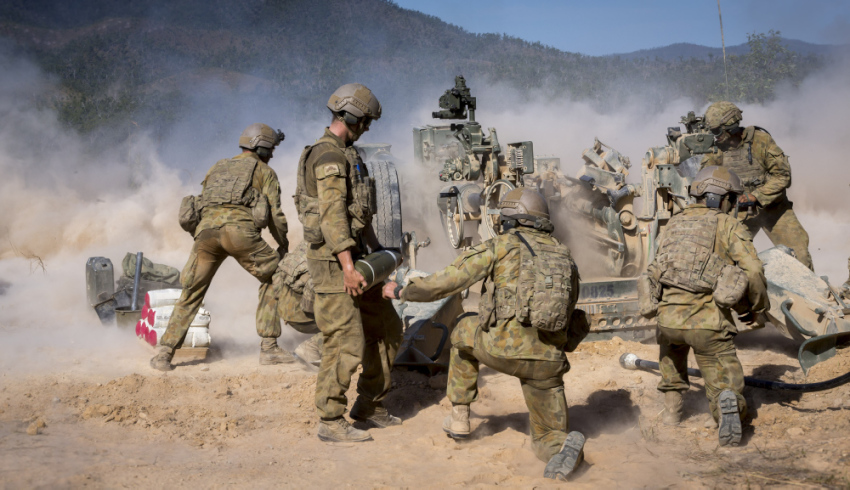Amid globally disrupted supply chains and an overreliance on overseas oil imports to power the country, how might the Australian Defence Force and its allies power tomorrow’s battlefield?
To continue reading the rest of this article, please log in.
Create free account to get unlimited news articles and more!
Planes, tanks, fighting vehicles and naval vessels all require a predictable supply of energy to maintain war readiness. A small miscalculation in available stock by a Commander on the battlefield, coupled with unfulfilled resupply requests, and an entire fighting force can be grounded. Meanwhile, forward operating bases, battlefield hospitals and largescale communications equipment compete in wartime for the available energy sources.
In the era of globally stretched supply chains and a reliance on overseas oil, a nation’s war fighting capability can quickly decrease to naught by strategic maritime and air blockades coupled with the inability to domestically extract critical resources to fuel the nation’s sovereign energy needs.
Twentieth century warfare has no shortage of examples where energy superiority translated into military superiority and battlefield victory.
“One of the most famous examples of energy influencing military strategy comes from 1911, when Winston Churchill, then First Lord of the Admiralty, converted the British fleet from Welsh coal to foreign oil. The resulting gain in speed and decrease in logistical burden gave the British Royal Navy a critical advantage over the Axis powers,” Constantine Samaras, Willian Nuttall and Morgan Brazilian wrote in Energy Strategy Reviews.
“While the shift from coal to oil was a decisive one for Winston Churchill and for the Royal Navy, the history of the First World War further reveals its status as the first major conflict fought, in part for energy. British strategy, reinforced by the Battle of Jutland (May 31st to June 1st 1916), relied on a blockade denying Germany and its allies access to global supply chains including most notably food, but also oil and other industrial resources.”
In fact, a 2020 report in the Center for Atmospheric Physics and Climatology Research at the Academy of Athens argued (via climate modelling) that favourable winds enabled the Greek fleet to beat the Persians at the Battle of Salamis in 480 BC, contending that the Persians had insufficient wind to escape the battle. Simply, one side had favourable energy capabilities that resulted in greater operational-strategic flexibility, and could thus overcome their competitors.
Indeed, the impact of energy shocks resulting from supply chain disruption are neither new nor unexpected. According to the International Energy Agency, countries are required to have reserve energy to meet 90 days worth of oil needs.
According to the latest Australian Petroleum Statistics report published by energy.gov.au, Australia only has 73 “IEA days of net import coverage”. While still falling short of the IEA’s mandated coverage, this is an improvement of 55 days at the end of 2019.
It still remains insufficient.
Mobile nuclear reactors
Throughout conflict, all energy stocks must be rationed to achieve both military outcomes as well as protect the livelihoods of the citizenry. As such, some analysts have floated the development of small and mobile nuclear reactors that could support the immense energy requirements of military bases.
The concept of mobile nuclear reactors was fleshed out by Jake Hecla of the Department for Nuclear Engineering at the University of California, Berkeley in War on the Rocks this week.
“Imagine the following scenario: A punishing conflict between NATO and Russia grinds on in Eastern Europe as winter closes in. Poland, starved of natural gas and with its civilian power grid under recurring cyber attack, suffers supply-line interruptions and unprecedented diesel shortages. NATO forces find themselves unable to meet their own energy needs at major bases. … Should the base prioritise powering up the drone-killing close-in weapons system or the surface-to-air missile battery?” Hecla hypothesised.
In response to these difficulties, Hecla outlined that the Department of Defense Strategic Capabilities Office has researched the possibility of developing mobile nuclear power plants to overcome such energy shortfalls, with the US Army previously dabbling in nuclear energy capabilities in the 1960s.
“Nuclear power is 10 million times more energy dense than fossil fuels and seems to be the ideal solution to securing a robust supply of electricity for the Army free of supply-line vulnerabilities,” Hecla noted.
Such energy requirements are likely to increase due to the growing sophistication of weapons systems, and as a result militaries are becoming more and more exposed to the vicissitudes of the global energy supply chain and thus need localised energy sources to be an effective fighting unit.
“This logic is driven in part by the development of ever more energy-intensive weapons systems as well as analysis that suggests the diesel supply chain for electricity generation has contributed significantly to casualties in past conflicts. As highlighted in a 2018 Army deputy chief of staff study, 52 per cent of causalities in Iraq resulted from attacks on land transport missions,” Hecla argued.
Nevertheless, Hecla argues that the vulnerabilities of mobile nuclear reactors simply outweigh their benefits. The mobile reactors have little resilience to munitions, could result in widespread radiation contamination and could even render many of the nearby equipment unusable even if the strike was only partially successful.
“Given these vulnerabilities, sophisticated adversaries seeking to hinder US forces are likely to realise the utility of the reactor as an area-denial target. In comparison to typical area-denial tactics that require constant use of munitions and can only continue as long as those munitions last, a reactor strike offers months of exclusion at the cost of only a few well-placed high-explosive warheads,” Hecla noted.
New doctrine
In the face of such supply chain and energy risks, the US Army has developed the doctrine of “Islandable” capabilities. This doctrine has been used to inform the future of the military’s energy needs, erring away from supply chain overreliance.
“To further support this requirement and help provide installations with a more resilient plan for assured energy, the Army Office of Energy Initiatives (OEI) is looking across the Army enterprise of installations for opportunities to develop 'islandable' capabilities, or projects and infrastructure that could allow installations to maintain mission-critical operations if or when the electric grid were to go down for an extended period,” Jack Surash, acting deputy assistant secretary of the Army for Energy & Sustainability, wrote on the US Army’s website in 2018.
“As part of potential energy resilience solutions, the Army is assessing viability and applicability of a wide range of technologies -- including but not limited to geothermal, combined heat and power, fuel cell and natural gas generation.”
While the notion of small mobile nuclear reactors might not solve the military’s energy crisis, the US Army has not simply accepted a reliance on global supply chains to enable war readiness.
Preparing for Australia’s energy resilience
Writing in Defence Connect in September, senator and retired Major General Jim Molan proposed several key policy areas to minimise Australia’s overreliance on global supply, overcome grey zone threats and maintain Australia’s operational capabilities.
Senator Molan asserted (direct quote from the article here):
- Prepare for more lethal and unattributable biological attack, cyber attack and denial of space capabilities;
- Examine further anti-trade measures that might be deployed against Australia – threats that discourage or stop shipping to and from Australia or make foreign shipping prohibitively expensive.
- Increase Australia’s liquid energy resilience by increasing the production of crude, our domestic refining capability, storage of crude and product, and the ability to move crude by ship, rail or pipeline from source to refinery, which may involve the domestic ownership of some oil tankers and rail rolling stock, and the construction of storage facilities for product;
- Encourage certain Australian companies by positive preference policies because they are domestic and important for national security, not just judging them on “value for money” and competitive advantage;
- Create and protect systems and processes for the modern mobilisation of the nation and to take advantage of the multitude of industrial skills and capabilities that need to be co-ordinated and focused;
- Set up a manpower and resources control organisation that can, when necessary, institute direction of manpower, skills and resources across the nation to warlike needs; and
- Support regional neighbours and allies against attempt to woo them away from Australian influence or reduce the effectiveness of alliances.
Your say
In the midst of an increasingly volatile Indo-Pacific, does Australia need a more robust energy resilience platform to both protect the war readiness of our ADF and the livelihoods of Australian citizens? And how might the Australian government achieve this policy? As always, let us know your thoughts in the comments.
Get involved with the discussion and let us know your thoughts on Australia’s future role and position in the Indo-Pacific region and what you would like to see from Australia's political leaders in terms of partisan and bipartisan agenda setting in the comments section below, or get in touch with
Liam Garman
Editor – Defence and Security, Momentum Media

 Login
Login








